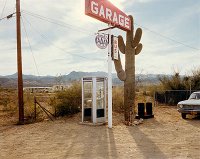Rudy Vanderlans: found landscapes




Rudy VanderLans' photo-fantasia Supermarket, a found word for a found landscape, folds together themes of non-places over the course of a drive through Southern California. These photographs summon a familiar loss and lonliness and raise questions about the everyday and the banal. Here again we see lawns, deserts, skies, and flatness. Here again are some of Shore’s signs and plantlife. VanderLans includes snatches of his sonic environment in his presentation, a kind of audio typography. There is a radio playing in his car as he drives. The D-shape of his car window becomes a major formal element, a lens used to classify the anonymous landscape. In 171 pages, not a single human being is depicted. Instead the work is a catalogue of like forms, the grid of four into which the photos are slid a kind of compound view, like that of a dung beetle or a closed-circuit television. Quadrants sputter alive with speech or images and then return to a blank, sandy beige. Each drugstore snapshot is horizontal, uniform, consistent, like the frames of a film whizzing quietly by.
On the outskirts of civilization, where suburban man stumbles over nature, an untold drama is taking place. A relentless effort by present day frontiersmen to tame and overcome the inhospitable California desert. Rudy VanderLans takes us to the heart of this spectacle, where suburban elements meet vacuous space, where dubious claims of commerce stand fragile against a harsh light, where contemporary dwellers impose incongruous notions of luxury on a magnificent wilderness landscape. Supermarket captures the folly and the beauty of this colorful drama in all its ambiguity, with astounding photographic spreads that come at us like film, taken at slightly different angles, juxtaposed or duplicated in singularly bold symmetry. For anyone who has traveled along the I-10 between downtown L.A. and Palm Springs, familiar icons punctuate a slow-moving blur: Fast food joints and car dealerships, palm trees against sky and mountains, concrete dinosaurs, signage.
The iteration of the images so leveraged simulates a spatiality that transcends the ordinary two-dimensional page. Supermarket is a disturbingly beautiful book that takes us on a poetic journey through Rudy VanderLans’ California, documenting our sometimes successful, sometimes futile attempt to transform an unfriendly environment into a bearable, happy land. VanderLans, brings us inside this desert environment in small steps, taking us along the California coast heading south and then east through the built environment, setting the scene for our final destination.
VanderLans' project is a formal stepchild to Gerhard Richter's Atlas, itself a catalogue of forms, of inspirations, of photographic brainstorming, a mapless map of a placeless place. The clarity of Richter's worldview is reinforced by its constancy, as it is in the Bechers' work, image after image of incremental difference; and totality, as it is in Sander's work, with a breadth that draws not just on the German landscape, but on that of all the world. Richter’s view includes everything we see and everything we've ever seen. It is Platonic: not a single landscape, but the idea of a landscape. And it is Socialist: each potential landscape is equivalent.
John Baldessari's work also uses this tactic. His photographs, like Richter's sixteen different arrangements of a wine bottle and apples by a window from Atlas, show a process of arrangement either by movement of objects within the frame or by movement of the photographer himself, and, because of this legislated sequential movement, the photographs can evoke gameplay and even rudimentary cinematic montage, as VanderLans’ photographs do. Both are simple narratives in which a limited set of forms plays out in succession.




